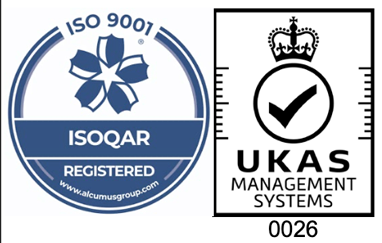Offshore Wind Farms in the UK
21st August, 2025
Offshore wind energy in the United Kingdom is substantial and growing, with numerous operational farms and ambitious plans for future wind farm expansion.
The UK is a global leader in the offshore and wind energy industry, with over 15GW of operating capacity which provides over 17% of the UK’s electricity needs. With a target to deliver 43-50GW of offshore wind by 2030, the UK has plans to retain and capitalise on its world-leading position in the industry.
Varied rubber materials are used across several different applications on offshore wind farms, all for different protective reasons. This guide will explore how renewable energy has developed in recent years and why wind farms are so important – including which wind farms are located in the UK – and why rubber is crucial for the offshore and wind industry.
What are offshore wind farms?
Offshore wind farms are groups of wind turbines located in bodies of water, most typically in the sea, that generate electricity from wind power. The electricity generated at these wind farms is transmitted to the shore through underwater cables before it is integrated into the electricity grid.
In 2024, offshore wind generated 48,927GWh, the most of any renewable source, showing just how offshore and wind energy has developed over recent years. Just under half of the UK’s electricity in Q4 of 2024 came from renewable sources, making renewables’ share of electricity generation eight percentage points greater than its share of overall energy production.
Offshore wind farms offer a clean and renewable energy source which reduces our reliance on fossil fuels, mitigating climate change issues. Our dependence on global fossil fuel markets decreases as we use wind power and the number of jobs available continues to increase as more wind farms become operational.
Wind Farms Across the UK
In the UK, there are 44 operational offshore projects with 2,824 offshore turbines according to data from RenewableUK.
Onshore wind farms are also in operation, with 2,656 operational projects in the UK. Power has been generated by onshore wind farms on a commercial scale since 1991, making it one of the cheapest sources of power generation in today’s society with over 10 million homes powered by onshore wind.
Offshore and wind energy in the UK comes from a range of offshore wind farms, some of which have been operational for multiple years whilst some are in the planning phases.
Blyth Offshore Wind Farm
In 2000, Blyth Offshore Wind Farm made history by hosting the UK’s first offshore wind turbines. At the time, these were the largest turbines installed offshore in the world. The wind farm was decommissioned in 2019, but there is a Wind Turbine Training Facility located in Blyth and the Port of Blyth is the seagreen cable base for Seaway 7 and construction base for the Sofia Offshore Wind Farm.
Blyth 2 Floating Offshore Wind Farm is a planned facility which will generate new energy and is located 14km off the Northumberland coastline.
Hornsea Projects
The Hornsea Projects are four offshore wind farms located in the North Sea.
Hornsea 1 became fully operational in 2020, followed by Hornsea 2, which entered operation in August 2022. Hornsea 1 was briefly the biggest offshore wind farm in the world, but Hornsea 2 shortly surpassed this.
Hornsea 3 was granted a Development Consents Order (DCO) in December 2020 and once operational, it will be capable of generating enough energy to power over 2 million homes. Hornsea 4 is currently in the pre-application phase.
Hywind Scotland
Operational since 2017, Hywind Scotland is the world’s first floating wind farm. It has five turbines and it demonstrates the feasibility of floating wind farms, showing they could be ten times larger.
Floating wind farms consist of turbines installed on platforms which are anchored to the seabed by flexible anchors, chains or cables. This type of offshore wind farm can provide higher wind potential since turbines are not located on fixed structures.
Rubber for Offshore and Wind Energy
Offshore wind farms remain complex, but they remain an important aspect of renewable energy and encouraging a cleaner planet. The complexities of offshore wind farms lie in the different applications needed to ensure a wind farm is fully operational.
Rubber is a vital material for these applications. It is a tough material which is resistant to corrosion and has thermal stability and flexibility which means it can protect mechanisms used in offshore wind farms and assist in unpredictable offshore operations.
Rubber products used in offshore and wind energy applications include:
- Rubber D Fenders are made using EPDM rubber because of its resistance to deterioration due to UV radiation, salinity and other environmental elements. Rubber D Fenders enhance marine safety because they reduce vibrations from vessels on docking facilities, ensuring safety for both vessel and offshore structure.
- Nitrile rubber offers good resistance to saltwater corrosion and abrasion, and is suitable for certain levels of pressure, making it an ideal material for use subsea cables which transmit electricity from the wind turbines to the shore. Therefore, it is essential that these cables are protected from harsh conditions.
- Neoprene is frequently used for boat landing systems to protect the coating of turbines from harsh impacts, which reduces damage to the wind turbines but also reduces noise pollution in the surrounding environments.
Choosing the right marine rubber for your offshore and wind energy industry application is crucial. The rubber materials must be appropriate to use within your specific applications, from vessels to subsea cables to floating platforms, so it is important to ensure you are using the right rubber products in the marine industry, especially for offshore wind farms.
Ready to improve your offshore and wind energy applications?
At Aquaseal Rubber, we have worked with multiple clients in the offshore and wind energy sector. We have worked with clients on a bespoke project developing rubber for offshore wind farms, on the supply of offshore wind turbine boat landing rubbers to be used in seawater conditions and on the fabrication of the unmanned offshore substation platform at the Galloper Wind Farm.
If you are looking for custom rubber solutions for your offshore and wind energy project, Aquaseal Rubber can support you. Contact us to see how we can work together.


